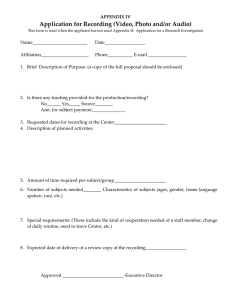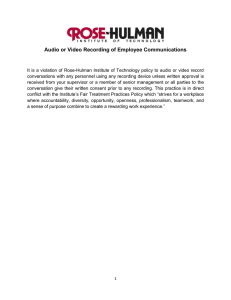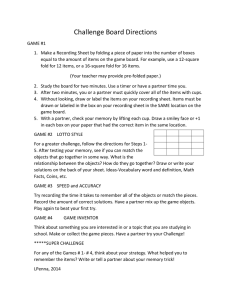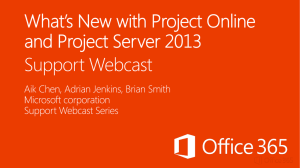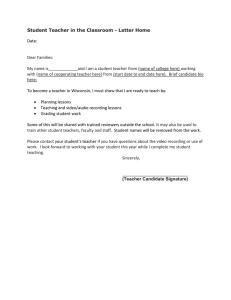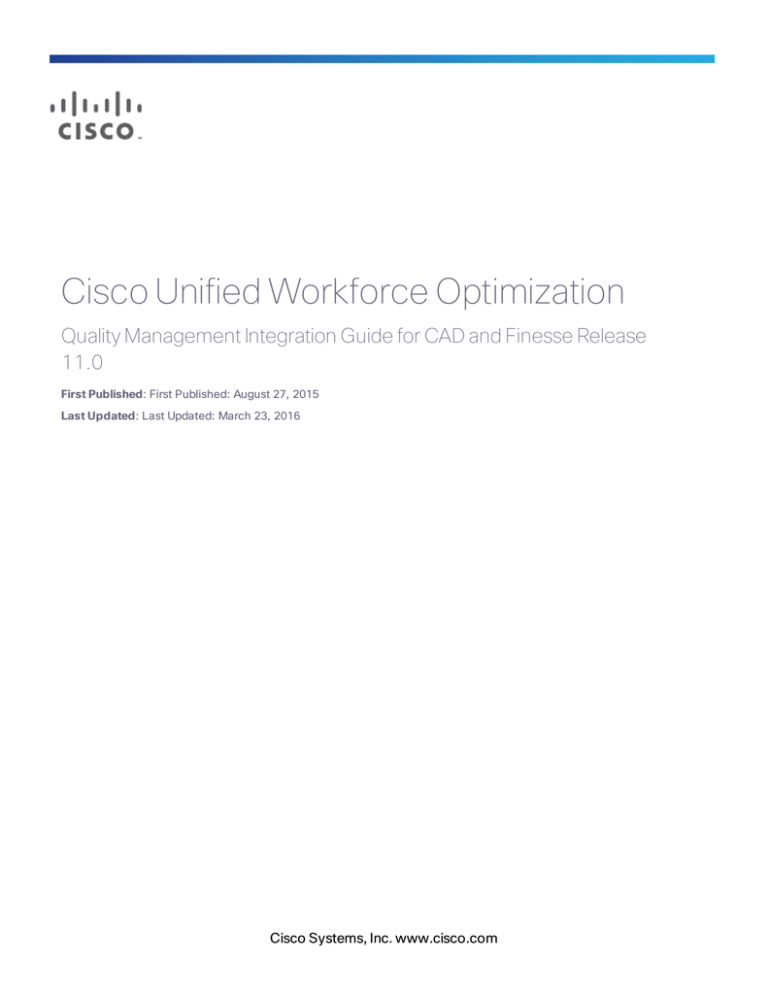
Cisco Unified Workforce Optimization
Quality Management Integration Guide for CAD and Finesse Release
11.0
First Published: First Published: August 27, 2015
Last Updated: Last Updated: March 23, 2016
Cisco Systems, Inc. www.cisco.com
THE SPECIFICATIONS AND INFORMATION REGARDING THE PRODUCTS IN THIS MANUAL ARE SUBJECT TO
CHANGE WITHOUT NOTICE. ALL STATEMENTS, INFORMATION, AND RECOMMENDATIONS IN THIS MANUAL ARE
BELIEVED TO BE ACCURATE BUT ARE PRESENTED WITHOUT WARRANTY OF ANY KIND, EXPRESS OR IMPLIED.
USERS MUST TAKE FULL RESPONSIBILITY FOR THEIR APPLICATION OF ANY PRODUCTS.
THE SOFTWARE LICENSE AND LIMITED WARRANTY FOR THE ACCOMPANYING PRODUCT ARE SET FORTH IN THE
INFORMATION PACKET THAT SHIPPED WITH THE PRODUCT AND ARE INCORPORATED HEREIN BY THIS
REFERENCE. IF YOU ARE UNABLE TO LOCATE THE SOFTWARE LICENSE OR LIMITED WARRANTY, CONTACT YOUR
CISCO REPRESENTATIVE FOR A COPY.
The Cisco implementation of TCP header compression is an adaptation of a program developed by the University of
California, Berkeley (UCB) as part of UCB's public domain version of the UNIX operating system. All rights reserved.
Copyright © 1981, Regents of the University of California.
NOTWITHSTANDING ANY OTHER WARRANTY HEREIN, ALL DOCUMENT FILES AND SOFTWARE OF THESE
SUPPLIERS ARE PROVIDED “AS IS" WITH ALL FAULTS. CISCO AND THE ABOVE-NAMED SUPPLIERS DISCLAIM
ALL WARRANTIES, EXPRESSED OR IMPLIED, INCLUDING, WITHOUT LIMITATION, THOSE OF MERCHANTABILITY,
FITNESS FOR A PARTICULAR PURPOSE AND NONINFRINGEMENT OR ARISING FROM A COURSE OF DEALING,
USAGE, OR TRADE PRACTICE. IN NO EVENT SHALL CISCO OR ITS SUPPLIERS BE LIABLE FOR ANY INDIRECT,
SPECIAL, CONSEQUENTIAL, OR INCIDENTAL DAMAGES, INCLUDING, WITHOUT LIMITATION, LOST PROFITS OR
LOSS OR DAMAGE TO DATA ARISING OUT OF THE USE OR INABILITY TO USE THIS MANUAL, EVEN IF CISCO OR
ITS SUPPLIERS HAVE BEEN ADVISED OF THE POSSIBILITY OF SUCH DAMAGES.
Any Internet Protocol (IP) addresses and phone numbers used in this document are not intended to be actual addresses
and phone numbers. Any examples, command display output, network topology diagrams, and other figures included in
the document are shown for illustrative purposes only. Any use of actual IP addresses or phone numbers in illustrative
content is unintentional and coincidental.
Cisco and the Cisco logo are trademarks or registered trademarks of Cisco and/or its affiliates in the U.S. and other
countries. To view a list of Cisco trademarks, go to this URL: www.cisco.com/go/trademarks. Third-party trademarks
mentioned are the property of their respective owners. The use of the word partner does not imply a partnership
relationship between Cisco and any other company. (1110R)
Quality Management Integration Guide for CAD and Finesse
© 2015, 2016 Cisco Systems, Inc. All rights reserved.
Contents
Introduction
4
Web Base Server Requirements
6
Recording Commands
8
Command Functions
8
Effects of Issuing Recording Control Commands
22
Active and Last Call
23
Using Commands with an Outbound Dialer
24
Integrating CAD with the Recording Controls API Commands
26
Enabling the Integrated Browser
26
Configuring an HTTP Request for the Metadata Command Example
26
Configuring an HTTP Request for the Stop Command Example
28
Integrating Finesse with Recording Controls API Commands
32
Example 1: Configuring an HTTP Request Action to Start Recording
32
Example 2: Configuring an HTTP Request Action for Metadata
33
Creating Gadgets in Finesse
Installing a Gadget
36
36
Introduction
You can integrate Cisco Agent Desktop (CAD) and Cisco Finesse with Cisco Unified
Workforce Optimization Quality Management via the Recording Controls API. CAD does
this via its Hypertext Transfer Protocol (HTTP) action. HTTP actions pass information in the
form of HTTP requests from the agent desktop to a third-party application (in this case,
the Recording Controls API) using HTTP methods.
Quality Management can record an agent’s calls from the agent’s desktop or from a
server. It supports the following recording scenarios.
n
Gateway Recording which includes:
n
n
Cisco MediaSense Recording
Agent Recording includes:
n
Desktop Recording
n
Network Recording
n
Server Recording (SPAN)
4
Web Base Server Requirements
You need the following information when sending a recording command.
n
Web Base server IP address
n
Port number for the Web Base server—the Web Base server listens on port 80 for
recording commands.
n
sender_id—when sending recording commands to a Web Base server, you need to
identify the Quality Management user associated with the command. You need to
pass an additional parameter called “sender_id” and give it the value of the user's
ID as known to the Quality Management Administrator. There is a variable available
in the CAD system that you can use for this purpose. CAD cannot send the sender_
id and the peripheral_id at the same time. You need to send each as separate
values.
n
QM workflow—Assign CAD agents to a team in Quality Management, assign the
team to a workflow, assign the team to a site, and then assign recording clusters to
the site.
Record Servers are available, to use the APIs. These recording clusters are not
associated with any Record Servers.
6
Recording Commands
This section explains the following concepts:
n
Syntax of recording commands
n
Function of each recording command
n
Active and last calls
n
Using commands with an outbound dialer
Command Functions
Recording commands allow you to control a recording.
You can use recording commands to record a call, pause the recording, and
attach metadata to a recording.
The following table describes how the recording commands interact with each other and
the Quality Management components.
8
Recording Commands
Recording commands
Command
Function
Records a call and uploads the call to the Quality Management
server at the end of the day.
In the Recording Controls API, the <command> is record.
The Tag command behaves as follows:
n
Agent Recording—marks a call for recording, even if
archiving is not enabled and the call does not meet the
workflow criteria. The Tag command overrides both the
Don’t Record list and the workflow classifiers.
n
Gateway/MediaSense Recording—marks a recording as
tagged if archiving is enabled and the call meets the
workflow criteria. The Tag overrides the workflow, but
does not override an exclusion list in the Exclusion List
window because the root contact does not know the
agent’s identity when recording. See “Recording
Controls Considerations for Gateway Recording” in the
Administrator Guide for more information.
Tag
Quality Management stores agent-tagged calls with the Agent
Tagged reason code, and saves them for the retention time
configured in Quality Management Administrator.
Agent Recording:
9
n
The Tag command is valid for the active call and the last
call.
n
If Quality Management is not recording the active call,
Quality Management starts recording the call when you
invoke the command and adds the Agent Tagged
reason code.
n
If Quality Management is recording two active calls (for
example, an inbound ACD call and an outbound
consultation call), Quality Management tags the call that
Recording Commands
Command
Function
triggered the recording to begin.
n
If Quality Management is not recording two active calls
(for example, an inbound ACD call and an outbound
consultation call), Quality Management begins
recording the first call sent to the agent, based on the
call start times, and tags the first call when you invoke
the Tag command.
Gateway/MediaSense Recording and Agent Recording:
n
When Quality Management actively recording a call, the
Tag command adds the Agent Tagged reason code to
the data associated with the call.
n
When Quality Management is not actively recording a
call, the Tag command changes the reason code associated with the last recorded call to the Agent Tagged
reason.
n
If Quality Management did not record the last call, nothing happens. Quality Management cannot update the
reason code when no recording is available.
10
Recording Commands
Command
Function
Temporarily halts the recording of:
n
Audio—the audio recording is silent for the duration of
the pause in the final recording where an agent discussed sensitive information.
n
Screen—the screen recording displays the following
message for the duration of the pause in the final
recording where an agent typed sensitive information on
the screen.
Screen recording paused
When you cannot record sensitive information (such as Social
Security numbers) for security or liability reasons, use the
Pause command. The Pause command allows you to omit
sensitive information from the final recording. This command
adheres to the Payment Card Industry Data Security Standard
(PCI DSS) for protecting consumer data.
Pause
Calls are available for playback prior to reconciliation with
silence where an agent used the Pause command. These calls
are accessible by anyone with the archive user role.
When using the Pause command, note the following:
n
n
11
Agent Recording:
n
The pause command is valid for active calls only.
n
If you send a pause command for a call currently
in the paused state, the pause command has no
effect.
n
The pause command does not affect live
monitoring.
Gateway/MediaSense Recording delays the pause.
The pause will appear in the recording after the recording is uploaded.
Recording Commands
Command
Function
Issue the Resume command when you want to start recording
after a pause.
Resumes recording after you issued a Pause command to stop
the recording.
Agent Recording:
n
The Resume command affects voice and screen
recording.
n
If the call is not currently paused, the Resume command
has no effect.
n
The Resume command is valid for active calls only.
n
If you do not use the Resume command, the point at
which you paused the recording is the end of the audio
recording.
n
A Resume command does not appear as a mutual
silence event or talkover event during post-call
processing.
Resume
12
Recording Commands
Command
Function
Restarts or starts the recording of a call.
The Restart command is not supported with Gateway
Recording and will be removed in a future release.
In the Recording Controls API, the <command> is restart.
Agent Recording:
n
If Quality Management is currently recording an active
call, the Restart command stops the audio and screen
recording, deletes that recording, and restarts recording
the call from the point when you issued the Restart
command.
n
If Quality Management is not currently recording an
active call, the Restart command starts audio and
screen recording.
n
The Restart command is valid for active calls only.
n
Quality Management assigns an Agent Tagged reason
code to calls recorded using the Restart command.
Quality Management saves the agent tagged calls even
if archiving is not enabled and the call does not meet
workflow criteria.
Restart
Gateway/MediaSense Recording does not support the Restart
command.
Use this command if you call someone and you are immediately
placed on hold for a long time. Issue the Restart command
when you leave the hold queue and begin speaking to a person.
This eliminates the period when you are on hold (for example,
20 minutes of recorded on-hold music).
13
Recording Commands
Command
Function
Marks a recording for deletion, even if archiving is enabled, the call meets
workflow criteria, the extension is in the inclusion list, or it is tagged for
retention. The Delete command deletes the recorded files and any
metadata, and uploads the basic contact data to Quality Management to
maintain accurate call counts.
In the Recording Controls API, the <command> is delete.
Delete
n
The Delete command is valid for the active call only.
n
The Delete command has precedence over all other
commands.
n
Once you delete a call you cannot record it by issuing
the Tag command.
n
Deleted calls are not available for archive purposes or
quality management purposes.
n
You cannot view deleted calls in Cisco Unified
Workforce Optimization.
n
For Gateway/MediaSense Recording, the recording is
deleted for the person who sends the command, but the
audio recording might continue to exist in the root call or
in other calls associated with this call.
Sends a login request that associates an agent with the specific extension for hot desking.
The Recording Controls IP Phone Service does not have
login/logout capabilities. Use Cisco’s Extension Mobility IP
Phone application to log in by phone.
Login
In the Recording Controls API, the <command> is login. You
must include the unique extension of the phone that the agent is
logging into.
This command is not supported if you are using
Gateway/MediaSense Recording.
14
Recording Commands
Command
Function
Sends a logout request that associates an agent with the specific extension for hot desking.
Logout
In the Recording Controls API, the <command> is logout.
This command is not supported if you are using
Gateway/MediaSense Recording.
15
Recording Commands
Command
Function
The Metadata command attaches metadata to an active call. If
Quality Management does not upload the current call (or
previous) for archiving because of workflow criteria, then the
metadata will be uploaded to the database but will not appear in
the interface.
In the Recording Controls API, the <command> is metadata.
You must include at least one key/value pair (<key>=<value> or
<key>:<value>).
Metadata
n
The Metadata command is valid for the active call and
the last call.
n
You can associate maximum of 30 metadata items with
a call. You can accomplish this with 30 Metadata
commands containing one key/value pair each, or one
Metadata command containing up to 30 key/value pairs.
n
You can only attach metadata defined in Quality
Management Administrator (Recordings > Metadata) to
a call. If you add an unknown key to a Metadata
command, Quality Management ignores the unknown
key.
The Metadata command interacts with the active call, including
the time up until the next call starts. If you invoke the Metadata
command during a call, Quality Management uploads the
metadata to the database at the same time as the rest of the call
data. If you invoke the Metadata command after the call but
before the next call, Quality Management uploads the metadata
separately at the time you invoke the command and Quality
Management stores the metadata with the last known call. Calls
that occur after a recorded call that do not match the inclusion
list are not counted as the next call.
Quality Management resets the last known call at
16
Recording Commands
Command
Function
login, so Quality Management cannot attach metadata
to the last known call before logout or shutdown after
the next login occurs. Quality Management attaches
metadata to calls that span the configured end of
day/upload time.
Successive calls to the Metadata command using the same key
name update the existing metadata for that call.
Specifying an empty value for a key removes that metadata field
association for the call.
Valid formats for metadata are as follows.
n
Dates—Dates must be in yyyy-mm-dd format (for
example 2009-09-24).
n
Numbers—Numbers can start with and contain a
decimal point (for example, valid numbers are .30, 10.7,
and 2500). Numbers cannot end with a decimal point or
contain a comma (for example, invalid numbers are 30.
and 2,500).
n
Text—Text key values cannot contain the reserved
characters, such as “&” or “=”.
All other alphanumeric characters are valid.
You can find the decimal point in the * key menu and the dash in
the zero key menu on your phone.
17
Recording Commands
Command
Function
Starts the audio and screen recording of an active call. This command
allows you to override the automatic exclusion lists to start recording their
current call and treat it as a normal contact.
In the Recording Controls API, the <command> is start.
Agent Recording:
Start Segment
n
If Quality Management is not currently recording an
active call, the Start Segment command starts audio
and screen recording.
n
If Quality Management is currently recording an active
call, the Start Segment command has no effect.
n
If the active call ends before the recording is stopped by
the agent, the recording is saved according to workflow
criteria.
n
The Start Segment command does not override the
workflow.
n
The Start Segment command does override the
exclusion list in the Exclusion List window.
If you are using an Outbound Dialer, you can
add the Outbound Dialer to the exclusion list to
prevent recording from starting when an agent
logs in. The agent can use the Start Segment
and Stop Segment commands to override the
exclusion list and record each outbound call.
For more information, refer to Using
Commands with an Outbound Dialer.
Gateway/MediaSense Recording does not support the Start
Segment command.
18
Recording Commands
Command
Function
Stops the audio and screen recording of an active call. The recording is
then saved according to workflow criteria as a new contact.
In the Recording Controls API, the <command> is stop.
Stop Segment
n
Agent Recording supports the Stop Segment command
only during active calls.
n
Gateway/MediaSense Recording does not support the
Stop Segment command.
The agent can use the Stop Segment command to stop the
recording after a sale has been made and before payment
information is taken in order to omit customer data in adherence
with PCI DSS.
19
Recording Commands
Command
Function
Starts screen recording regardless of whether or not you are
participating in an active call. Use this command to record chat
or email interactions with a customer.
Voice contact recordings and screen only contact recordings
can be bracketed or interleaved.
You can send the Start Screen command to record
your screen while not participating in an active call. If
you receive a phone call or make a call during this time,
a separate voice and screen contact might be created
according to workflow (or you can send the Start
Segment and Stop Segment commands to create the
contact). After the active call has ended, another
screen only contact is created and will continue until
you send the Stop Screen command.
Start Screen
In the Recording Controls API, the <command> is start_screen.
Agent Recording:
n
The Start Screen command is only supported with the
Advanced bundle.
n
If Quality Management is not currently recording an
active call, the Start Screen command starts screen only
recording.
n
If Quality Management is currently recording an active
call, the Start Screen command has no effect on the
current recording. The screen only recording will begin
after the active call has ended (if the Stop Screen
command has not been issued). The call recording and
the screen only recording are saved as separate contact
recordings.
Gateway/MediaSense Recording does not support the Start
20
Recording Commands
Command
Function
Screen command.
After issuing the Start Screen command, you can send other
commands. The following list contains the commands that are
supported with screen only recording and the expected
behavior.
n
Pause—Pauses the current screen only recording
n
Resume—When sent after the Pause command,
resumes the screen only recording
n
Restart—Stops the screen only recording, deletes that
recording, and restarts the screen only recording from
the point when you issued the Restart command.
The Restart command is not supported with
Gateway Recording and will be removed in a
future release.
n
Delete—Deletes the screen only recording. You must
send the Stop Screen command either before or after
the Delete command in order to be able to send the
Start Screen command again to start another screen
only recording.
n
Metadata—Attaches metadata to the active screen only
recording
All other commands have no affect on the current screen only
recording.
Issue the Stop Screen command to stop screen only recording.
21
Recording Commands
Command
Function
Stops screen recording.
In the Recording Controls API, the <command> is stop_screen.
Agent Recording:
n
The Stop Screen command is only supported with the
Advanced bundle.
n
If Quality Management is currently recording screen
only, the Stop Screen command stops the screen
recording. The Stop Screen command only has an
effect if you previously issued the Start Screen
command.
n
If the Stop Screen command is not sent after the Start
Screen command, the maximum contact recording
length is 4 hours.
Stop Screen
Gateway/MediaSense Recording does not support the Stop
Screen command.
Displays configuration information for the specified user. A user is configured for desktop recording if no serverHost is returned. In this case you
need to send commands via the applet, not the server.
Config
Effects of Issuing Recording Control Commands
The following table indicates the effect of issuing a recording command when the call is
currently being recorded, and when the call is not being recorded.
Effect of issuing recording control commands on calls
Command
Currently Recording
Not Currently Recording
Tag
Sets Reason Code to TAGGED.
Call recording starts. Sets
Reason Code to TAGGED.
Pause
Recording paused.
None.
Resume
Recording resumes (if previously
paused).
None.
22
Recording Commands
Command
Currently Recording
Not Currently Recording
Restart
Recording restarts. Sets Reason Code to
TAGGED.
Recording starts. Sets
Reason Code to TAGGED.
Delete
Call deleted.
None.
Start Segment
None.
Recording starts.
Stop Segment
Recording stops and is saved according
to workflow criteria.
None.
Start Screen
If there is a current voice and screen
recording, the Start Screen command
has no effect on the current recording.
The screen only recording will begin
after the active call has ended (if the
Stop Screen command has not been
issued) and will be created as a separate contact recording. If there is a current screen only recording, the Start
Screen command has no effect.
Screen only recording starts.
Stop Screen
If there is a current screen only recording, screen recording stops. The Stop
Screen command only has an effect if
you previously issued the Start Screen
command.
None.
Active and Last Call
You must understand the difference between the terms active call and last call. Some
commands can apply to either one of these call types. Some commands can apply to a
single call type.
An active call occurs when the Quality Management user is on a call with one or more
parties. A call on hold is still an active call. The active call starts when the Quality
Management user receives the call (phone is ringing) or makes a new call. The active call
ends when the user hangs up the phone.
The last call is the previously recorded call. Any valid recording commands sent after a call
ends, and until another call, that matched the inclusion list, is received or made by the user,
apply to the last call.
The following table indicates whether the recording command applies to the active call,
the last call, or both.
23
Recording Commands
Recording commands that support Active Calls or Last Calls
Command
Active Call
Last
Call
Pause
Yes
No
Resume
Yes
No
Tag
Yes
No
Restart
Yes
No
Delete
Yes
No
Login
No—The recording command applies to the next active
call.
No
Logout
Yes—An active call stop recording.
No
Metadata
Yes
Yes
Metadata and &active_call_onlyy=true
Yes
No
Start Segment
Yes
No
Stop Segment
Yes
No
Start Screen
Yes—And when there is no active call.
No
Stop Screen
Yes—And when there is no active call.
No
Using Commands with an Outbound Dialer
An outbound dialer creates a single “nailed up” call for the entire time you are logged in.
This results in all of your outbound calls being combined into one large recording, even
though you might make numerous outbound calls during your session. Use the Start
Segment and Stop Segment commands to break this large nailed up call into multiple
contact recordings.
Send the Start Segment command at the beginning and the Stop Segment command at
the end of each outbound call to create a unique contact recording for each outbound call.
The Start Segment command starts the audio and screen recording of an active call. The
Stop Segment command stops the recording. The recording is then saved according to
workflow criteria as a new contact. Send the Start Segment command again at the
beginning of your next outbound call to start another unique contact recording.
24
Recording Commands
You can also add the Outbound Dialer to the exclusion list to prevent recording from
starting when an agent logs in. The agent can use the Start Segment and Stop Segment
commands to override the exclusion list and record each outbound call.
For information about commands, refer to Command Functions.
25
Integrating CAD with the Recording Controls API Commands
This section provides examples on how to integrate CAD with the Recording Controls API
commands. The examples provided in this section includes:
n
Tasks for configuring an HTTP Send Action to invoke the Metadata command to
the Web Base server
n
Task for configuring an HTTP Send Action to invoke the Stop command
Enabling the Integrated Browser
Before you can use HTTP actions, you must configure the Cisco Desktop Work Flow
Administrator to support an integrated browser.
To enable the integrated browser in Cisco Desktop Work Flow Administrator:
1. From Cisco Desktop Work Flow Administrator, drill-down to CAD Agent > User Interface.
2. Select the Enable Integrated Browser check box and then click Apply.
Configuring an HTTP Request for the Metadata Command Example
Before configuring an HTTP Request for the Metadata command in CAD, configure the
user-defined metadata in Quality Management Administrator. See the Quality
Management Administrator Guide for more information. This example uses the following
metadata: agentname.
Use the following example to configure an HTTP request for the Metadata command. The
HTTP request command sends the Metadata command to the Cisco Recording Controls
on the Web Base server.
1. In Cisco Desktop Work Flow Administrator, create a new HTTP request in the HTTP
Action Setup dialog box by completing the fields as follows:
n
Action Name: Metadata_CallSegment_1
n
Protocol: http
n
Host: <Web Base server IP address>
26
Integrating CAD with the Recording Controls API Commands
where <Web Base server IP address> is the IP address or hostname for the
Web Base server. Note that this address is case sensitive.
n
Port: 80
n
Path: recordingcontrols/rest/metadata
The following figure shows an example of a completed HTTP Action Setup dialog box.
2. In the Request Data section, click Add.
The HTTP Request Data Dialog box appears.
3. Complete the fields and then click OK to close the HTTP Request Data Dialog box. For
example:
n
Value Name: <key name>
where <key name> is the Key Name configured in Quality Management
Administrator
27
Integrating CAD with the Recording Controls API Commands
agentname
n
Value Type: UserDefined
n
Value: [SYSTEM:AGENT_NAME]
The following figure shows an example of a completed HTTP Request Data Dialog box
for the “agentname” metadata field.
4. Continue adding HTTP request data for each metadata field configured in Quality
Management (up to a total of 10 fields). The HTTP Request data also requires the
sender_id and the peripheral_id (in this order).
All commands require the sender_id and peripheral_id.
5. Click OK to save HTTP Action Setup.
Configuring an HTTP Request for the Stop Command Example
Use the following example to configure an HTTP request for the Stop command. The
HTTP request command sends the Stop command to the Cisco Recording Controls on
the Web Base server.
1. In Cisco Desktop Work flow Administrator, create a new HTTP request in the HTTP
Action Setup dialog box by completing the fields as follows:
n
Action Name: Stop
n
Protocol: http
n
Host: <Web Base server IP address>
n
Port: 80
n
Path: recordingcontrols/rest/stop
28
Integrating CAD with the Recording Controls API Commands
The following figure shows an example of a completed HTTP Action Setup dialog box.
2. In the Request Data section, click Add.
The HTTP Request Data Dialog box appears.
3. Complete the fields and then click OK to close the HTTP Request Data Dialog box. For
example:
Field Name
Value
<key name>
Value Name
where <key name> is the Key Name configured in Quality
Management Administrator
agentname
29
Integrating CAD with the Recording Controls API Commands
Field Name
Value
Value Type
UserDefined
Value
[SYSTEM FIELD:LOCAL_PHONE:EXTENSION]
Test Data
3420
The following figure shows an example of a completed HTTP Request Data Dialog box
for the “extension” field.
4. Add the HTTP Request data for the sender_id and the peripheral_id (in this order).
All commands require the sender_id and peripheral_id.
5. Click OK to save HTTP Action Setup.
30
Integrating Finesse with Recording Controls API Commands
This section provides examples on how to configure Quality Management Recording
Controls API commands from the Cisco Finesse Administrator. To do this, you must
perform the following steps:
1. Create an HTTP Request workflow action. See “Add HTTP Request Workflow Action”
in the Cisco Finesse Administration Guide.
2. Assign the action to a workflow that will trigger on “When a Call is answered”. See
“Edit Workflow” in the Cisco Finesse Administration Guide.
3. Assign the workflow to a team of agents. See “Assign Workflows to Team” in the
Cisco Finesse Administration Guide.
Once the workflow action is configured, the Recording Controls API commands are
invoked from the Cisco Finesse Desktop when an agent answers a call.
Example 1: Configuring an HTTP Request Action to Start Recording
The following is an example of configuring an HTTP request action to start recording in
Cisco Finesse.
In Cisco Finesse Administrator, create a new HTTP request action by completing the fields
as follows.
Use the tag icon at the right of the box to select variables (such as loginID as
shown in the example) from the drop-down list when entering variables in the
body of the request action. The resulting string looks like this:
Field
Value
Name
QM Record Start
Type
HTTP Request
Handled by
Finesse Desktop
Method
POST
32
Integrating Finesse with Recording Controls API Commands
Field
Value
Other
Location
Do not specify the location as Finesse.
Content Type
text/json
URL
http://<Web Base server IP address>/recordingcontrols/rest/start
Body
{ "peripheral_id": "1", "sender_id": “loginId" }
Example 2: Configuring an HTTP Request Action for Metadata
The following is an example of an HTTP request action for metadata in Cisco Finesse. This
example shows using the metadata command to set the account number and agent’s
login ID for the call.
Workflows and actions are configured in the Cisco Finesse Administration
Console. The workflows must be performed when the Dialog (call) ends.
Otherwise, the metadata is tagged to the recording of the agent's previous call,
not the current call.
In Cisco Finesse Administrator, create a new HTTP request action by completing the fields
as follows.
Use the tag icon at the right of the box to select variables (such as loginID and
callVariable1 as shown in the example) from the drop-down list when entering
variables in the body of the request action. The resulting string looks like this:
Field
33
Value
Name
QM
Type
HTTP Request
Handled by
Finesse Desktop
Integrating Finesse with Recording Controls API Commands
Field
Method
Value
POST
Other
Location
Do not specify the location as Finesse.
Content Type
text/json
URL
http://<Web Base server IP address>/recordingcontrols/rest/metadata
Body
{ "peripheral_id": "1",
"sender_id": "loginId",
"metadata": {
"account" : "callVariable1"
"active_call_only":false
}
}
34
Creating Gadgets in Finesse
This section explains how to install the gadgets on a Finesse server. The following gadgets
are available:
n
Cisco Recording Controls gadget—a Finesse URL gadget wrapper for
Cisco Recording Controls
n
Cisco Quality Management Playback gadget—a Finesse URL gadget wrapper for
playing back recordings from Cisco Unified Workforce Optimization
Installing a Gadget
To install a gadget:
1. Log in to the Quality Management Web Base server and copy one of the following
folders to a safe location:
n
For the Cisco Recording Controls gadget:
C:\Program Files\Cisco\WFO_QM\Jetty\work\cone_
ui\webapp\gadgets\RecordingControlsGadgetFinesseURL-10.5.1
where <version> is the version number.
n
For the Cisco Quality Management Playback gadget:
C:\Program Files\Cisco\WFO_QM\Jetty\work\cone_
ui\webapp\gadgets\PlayBackGadget_9_3_1
2. Open the RecordingControls.xml or FinessePlayBackGadget.xml and make the following changes:
a. (Recording Controls and Finesse Playback) Change the IP address passed to the
finesse.modules.EmbeddedWebAppGadget.init function in this XML file to match
your Quality Management Web Base server address.
b. (Recording Controls only) Change the peripheral_id passed to the finesse.modules.EmbeddedWebAppCadget.init function to match your Quality Management system. That is 1 for Unified CCX.
3. Log in to the Finesse server.
4. Upload all the files from your safe location to the Finesse 3rdpartygadget folder on the
36
Creating Gadgets in Finesse
Finesse server as described in the Cisco Finesse Web Services Developer Guide on the
Cisco DevNet website. When uploading the files, note the following:
n
You will need to create a RecordingControls or PlayBackGadget folder for the
gadget files that avoids naming conflicts with other third-party gadget files.
n
You will need to add the gadget to your Finesse layout as follows:
For the Cisco Recording Controls gadget:
<gadget>/3rdpartygadget/files/RecordingControls/Recording
Controls.xml</gadget>
The gadget will appear as follows within the Finesse Agent Desktop.
For the Cisco Quality Management Playback gadget:
<gadget>/3rdpartygadget/files/FinessePlayBackGadget/Fines
sePlayBackGadget.xml</gadget>
Once you enter you Cisco Quality Management username and password, the
gadget will appear as follows within the Finesse Agent Desktop.
37

